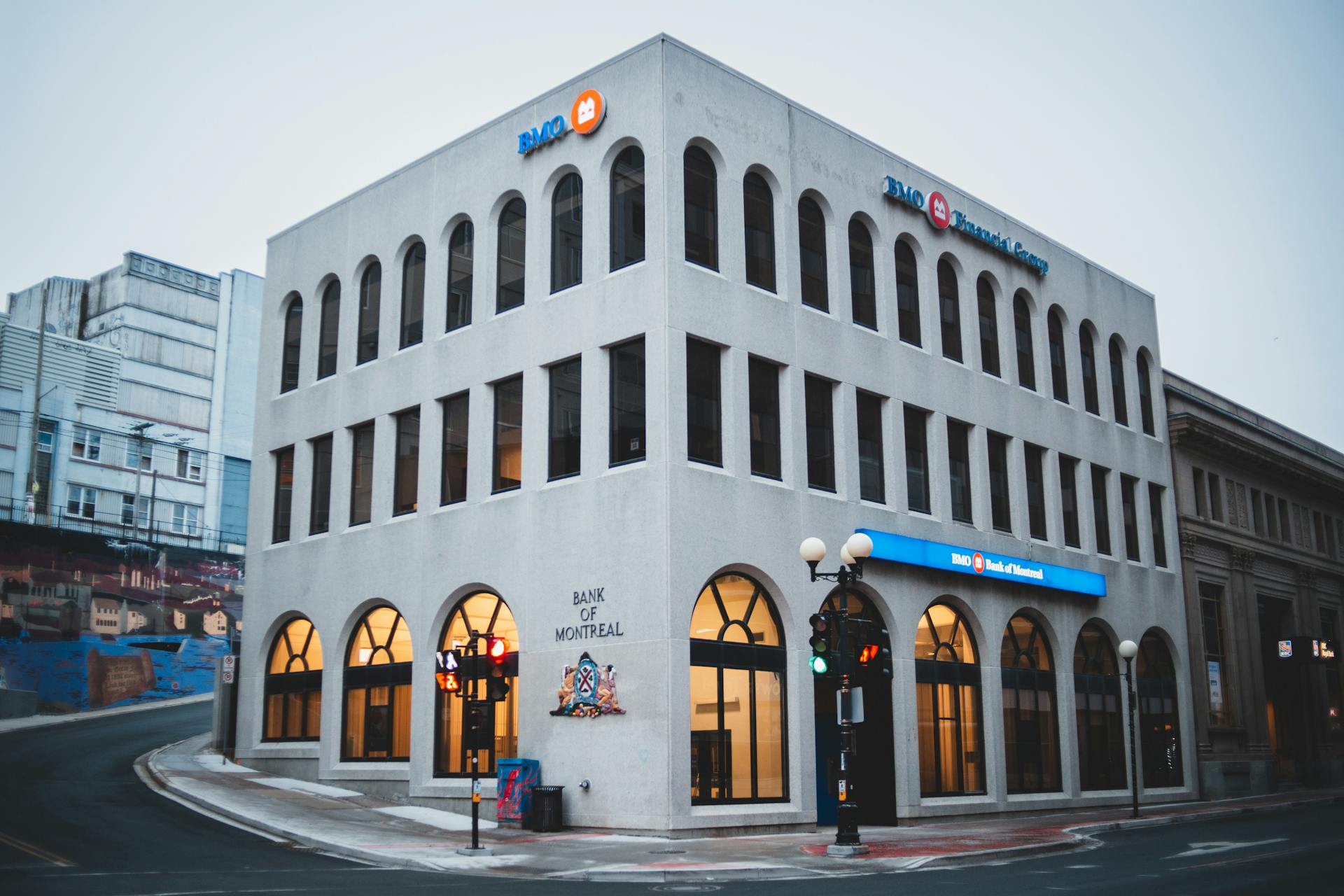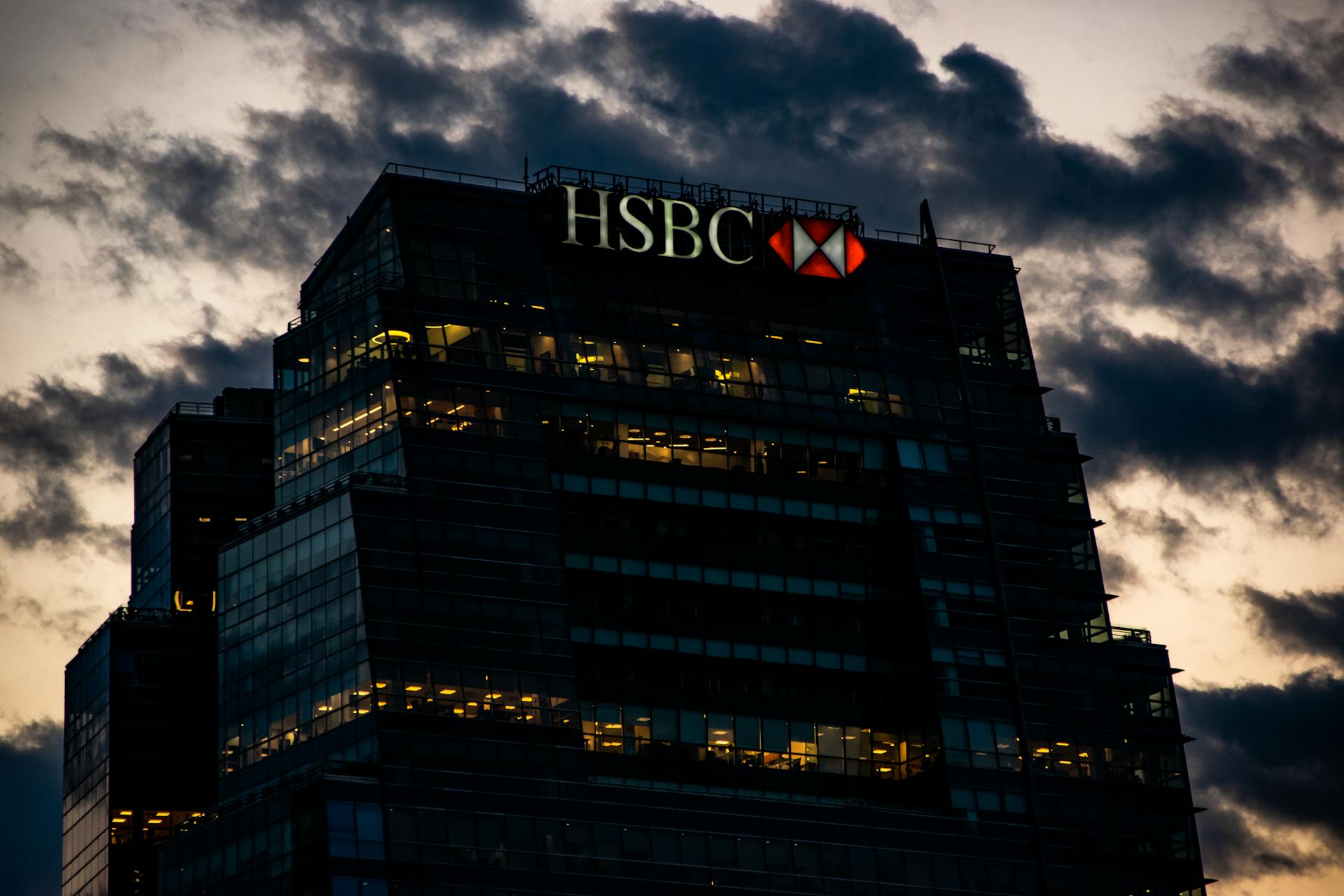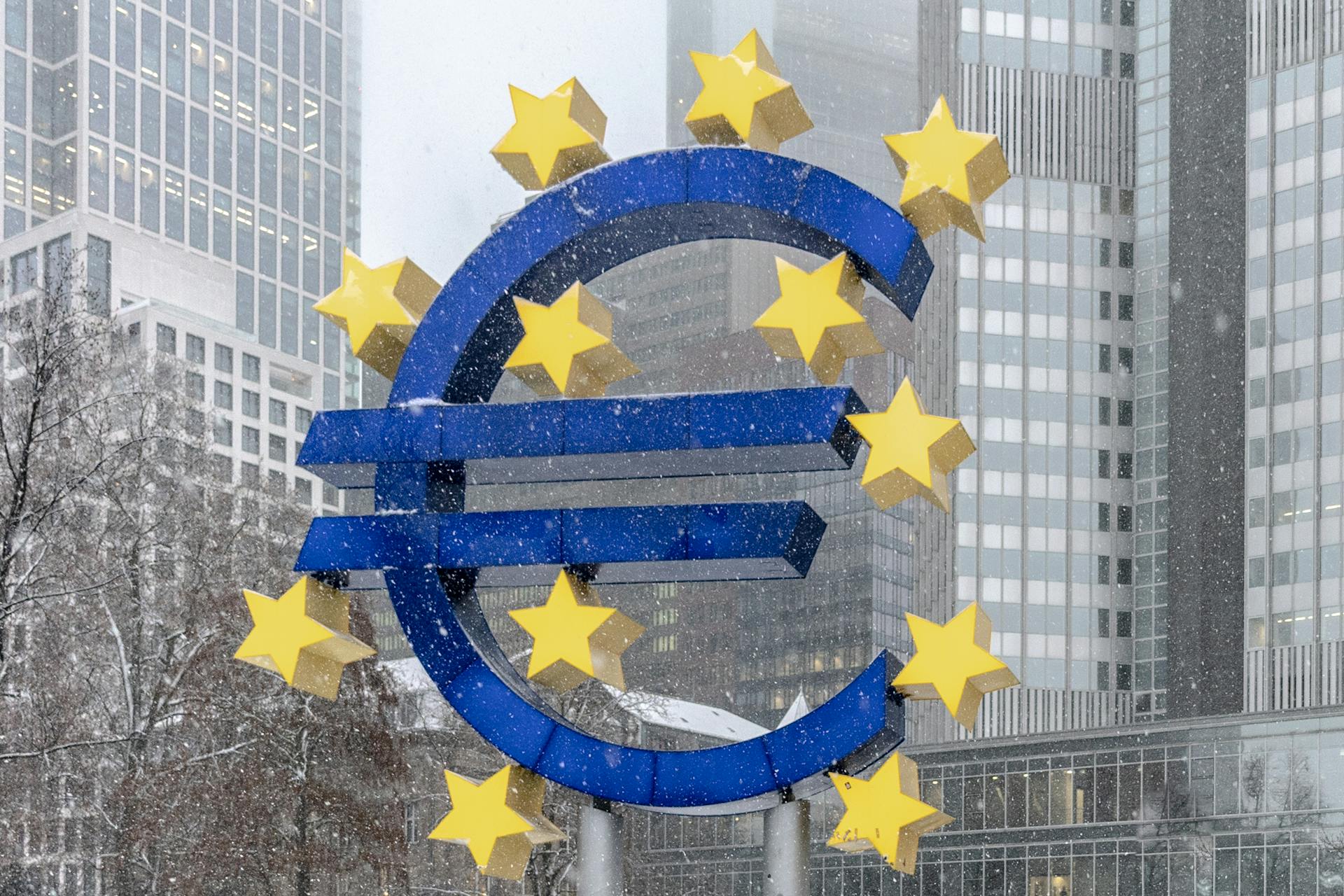
The Hungarian Development Bank is a state-owned financial institution that plays a crucial role in Hungary's economic development. It was established in 1995 to provide financing for small and medium-sized enterprises (SMEs) and infrastructure projects.
The bank's primary objective is to support economic growth and job creation in Hungary. It achieves this by offering a range of financial products and services, including loans, guarantees, and equity investments.
The Hungarian Development Bank has a strong focus on supporting SMEs, which account for a significant proportion of Hungary's economy. In 2020, the bank provided over 1,500 loans worth HUF 120 billion to SMEs.
One of the bank's key areas of focus is infrastructure development, including transportation and energy projects.
Intriguing read: NCB Financial Group
History and Structure
The Hungarian Development Bank, or MFB, has a unique structure that's defined by the MFB Act. Act XX of 2001, as amended, states that MFB is a private limited company with a single member: the Hungarian State.
Readers also liked: Hungarian National Bank
The state is represented by the minister responsible for supervising state-owned assets, who has been the Minister for National Development since June 2010. This minister has the power to exercise the rights of the owner.
The board of directors and the supervisory board oversee the managing, decision-making, and controlling organs of the Bank. The members of the board of directors are appointed for a period of five years and can be removed by the person exercising the rights of the owner.
The board of directors elects its own chair from among its members, while the supervisory board's chair is appointed and can be removed by the person exercising the rights of the owner. The CEO, who is an employee of MFB Zrt, heads the work organization.
The MFB Act defines the tasks and financial service provision activities of the bank, as well as rules regarding conflict of interest and confidentiality. For instance, members and employees of the board of directors and supervisory board cannot hold office in political parties or undertake public roles in the name or interest of any political party, except for participating in elections as a candidate.
Financial Activities
Hungarian Development Bank's financial activities are quite impressive. They perform their objectives through various activities, including distributing EU funds through financial instruments.
These financial instruments are a combination of loan and venture capital programmes. They also offer lending services, both directly and through Group members. MFB Zrt. even provides equity financing through Group members.
In addition to these services, MFB Zrt. offers guarantees and student loans through a Group member. They also engage in claim work-out activities through the same Group member.
MFB Zrt. is quite active in the capital markets, raising funds both domestically and internationally. These funds are used to finance development loans, programs, and projects, with repayment guaranteed by the Hungarian State.
Some of the ways MFB Zrt. raises funds include issuing bonds on the Budapest Stock Exchange. They even issue green and social bonds, which is a great way to promote sustainable development.
Here are the financial activities of MFB Zrt. in a nutshell:
- Distribution of EU funds through financial instruments
- Lending services (direct and through Group members)
- Equity financing (through Group members)
- Guarantees
- Student loans (through a Group member)
- Claim work-out activities (through a Group member)
- Capital market transactions (issuing bonds on the Budapest Stock Exchange)
The MFB Group
The MFB Group is a collection of companies under the Hungarian Development Bank's umbrella. MFB exercises the rights of the owner on behalf of the Hungarian State in some of these companies.
The MFB Act defines two main categories of companies that belong to the MFB Banking Group. These categories are based on the legal ownership structure of the companies.
MFB holds ownership interest in some companies within the group, while in others, it exercises the rights of the owner on behalf of the Hungarian State.
MFB Zrt International Memberships
MFB Zrt is a member of several prestigious international associations that demonstrate its commitment to collaboration and innovation.
The European Association of Public Banks – EAPB is one of the notable memberships of MFB Zrt. This association brings together public banks from across Europe to share knowledge and best practices.
MFB Zrt is also a part of the European Venture Fund Investors Network – EVFIN, which focuses on supporting venture capital investments in the region.
Here's an interesting read: European Merchant Bank

The Network of European Financial Institutions for SMEs – NEFI is another significant membership of MFB Zrt, aiming to promote financial inclusion for small and medium-sized enterprises.
MFB Zrt has a strong presence in the European Investment Fund – EIF, which provides financing and advisory services to support small and medium-sized enterprises.
The European Association of Long-Term Investors – ELTI is another notable membership of MFB Zrt, emphasizing the importance of long-term investments.
MFB Zrt's membership in the Banking Association for Central and Eastern Europe – BACEE highlights its commitment to regional cooperation and development.
The Institute of International Finance – IIF is a global association of financial institutions, and MFB Zrt is proud to be a part of it.
MFB Zrt is also a member of the International Chamber of Commerce, Hungary – ICC, Hungary, which promotes international trade and commerce.
Here are some of the key international associations that MFB Zrt is a part of:
- European Association of Public Banks – EAPB
- European Venture Fund Investors Network – EVFIN
- Network of European Financial Institutions for SMEs – NEFI
- European Investment Fund – EIF
- European Association of Long-Term Investors – ELTI
- Banking Association for Central and Eastern Europe – BACEE
- Institute of International Finance – IIF
- International Chamber of Commerce, Hungary – ICC, Hungary
The MFB Group

The MFB Group is a network of companies with a unique structure. MFB exercises the rights of the owner on behalf of the Hungarian State in some of these companies.
The MFB Act defines two groups of companies that belong to the MFB Banking Group. One group consists of business organizations where MFB holds ownership interest.
A company can be part of the MFB Banking Group on either of two legal bases. This provides flexibility in the way the group operates.
The MFB Act provides an itemized list of the companies that belong to the MFB Banking Group. This list is a useful resource for understanding the scope of the group.
The minister responsible for the supervision of state-owned assets represents the Hungarian State in MFB, giving them the authority to exercise the rights of the owner. This is a key aspect of the MFB Group's governance structure.
Additional reading: List of Investment Banks
Management and Strategy
The Hungarian Development Bank has a clear strategy in place to drive economic growth in Hungary. Becoming an active driver of economic goals is a key part of this strategy.
Recommended read: Arab Bank for Economic Development in Africa

The bank focuses on strategically important economic sectors, providing loan, equity and guarantee, as well as tailor-made financial advisory services. This support helps businesses thrive and create jobs.
The bank also plays a crucial role in distributing EU funds, acting as the body implementing the fund of funds and the holding fund. This allows it to participate in centralised EU programmes and build powerful relations with international institutions.
International Partners
MFB Zrt. has a strong presence in the international arena, with a network of partnerships that facilitate its growth and development.
The organization is a member of several prominent international associations, including the European Association of Public Banks – EAPB, the European Venture Fund Investors Network – EVFIN, and the Institute of International Finance – IIF.
These memberships provide MFB Zrt. with access to a wealth of knowledge, best practices, and networking opportunities that help the organization stay ahead in the global market.
Here are some of the key international partners of MFB Zrt.:
- European Investment Bank – EIB
- European Investment Fund – EIF
- Council of Europe Development Bank – CEB
- European Commission – EC
These partnerships enable MFB Zrt. to tap into new markets, leverage expertise, and drive innovation, ultimately benefiting its clients and the wider community.
CEOs
The CEOs of the organization have played a crucial role in shaping its management and strategy over the years.
Dr. Miklós Bányai was the first CEO, serving from 1991 to 1994. He was followed by Dr. Péter Medgyessy, who led the organization from 1994 to 1996.
A total of 11 CEOs have led the organization since its inception, with Dr. János Erős serving as CEO for an impressive 8-year period from 2002 to 2010.
Here's a list of all the CEOs who have led the organization:
- Dr. Miklós Bányai, 1991–1994
- Dr. Péter Medgyessy, 1994–1996
- Dr. András Huszty, 1996–1998
- Dr. Péter Patonai, 1998–2000
- Dr. Éva Búza, 2000–2001
- László Baranyay, 2001–2002
- Dr. János Erős, 2002–2010
- László Baranyay, 2010–2013
- Csaba Nagy, 2013–2016
- Tamás Bernáth, 2016-2019
- Dr. Levente Sipos-Tompa, 2019-
Strategy
Becoming an active driver of economic goals in Hungary is a key strategy. This involves emphasizing strategically important economic sectors, such as those that can drive growth and job creation.
The organization provides loan, equity, and guarantee services, along with tailored financial advisory services. This helps businesses and entrepreneurs access the funding they need to succeed.
Consider reading: Banks and Banking Services
Additional financing options are also available, including development-type financing that can help stimulate the Hungarian economy. This can include investments in infrastructure, innovation, and other areas that drive growth.
The organization plays a critical role in distributing EU funds, acting as the implementing body for the fund of funds and the holding fund. This involves working closely with other stakeholders to ensure that EU funds are used effectively to support economic development.
The organization participates in centralised EU programmes, which helps to leverage additional funding and resources. This can include participation in joint initiatives and projects with other EU countries and institutions.
The organization has strong relationships with international institutions, which enables it to participate in various forms of international cooperation. This can include partnerships with other development agencies, international financial institutions, and global organizations.
Here are some of the key strategies and initiatives that the organization is involved in:
- Becoming an active driver of economic goals in Hungary;
- Emphasising strategically important economic sectors;
- Providing loan, equity and guarantee, with tailor-made financial advisory services;
- Providing additional, development-type financing for the Hungarian economy;
- Distribution of EU funds as the body implementing the fund of funds and the holding fund;
- Participation in centralised EU programmes;
- Powerful relations with international institutions and participation in various means of international cooperation.
Analysis and Ratings
The Hungarian Development Bank has a robust economic analysis system in place, with the MFB Periscope report providing a monthly snapshot of the Hungarian economy and its wider environment. This report offers valuable insights into current trends and developments.
The MFB Indicator is a biannual survey that collects data from hundreds of Hungarian business units, providing a comprehensive picture of the economy through four key indices: macroeconomic, market, financing, and investment. These indices have been tracking the economy since summer 2009.
The bank's balance sheet data shows a significant increase in the balance sheet total, from 1.94 trillion HUF in 2020 to 3.61 trillion HUF in 2023. Similarly, the subscribed capital has remained relatively stable at 519.9 million HUF since 2020, while the equity has increased from 411.7 million HUF to 724.4 million HUF over the same period.
Here is a breakdown of the key balance sheet data:
Analyses
The Hungarian Development Bank has a few tools up its sleeve to analyze the economy. MFB Periscope is a monthly report that breaks down current trends in the real economy and money markets.
This report focuses on the Hungarian economy and its wider environment, giving it a corporate and banking perspective. The bank uses this report to interpret recent developments and provide insights into the economy.
The MFB Indicator is a biannual survey that collects data from hundreds of Hungarian business units. This survey is built around four key indices: a macroeconomic index, a market index, a financing index, and an investment index.
These indices provide a detailed picture of the Hungarian economy and its processes. The data collected since 2009 gives a thought-provoking view of the economy's state and trends.
The MFB Macroeconomic Analyses offer a periodic overview of global economic processes. This helps the bank assess the Hungarian economy's constraints and opportunities in the context of international trends.
Here's a summary of the key balance sheet data and results:
Rating Rationale
The Hungarian Development Bank's MFB has received a rating from Scope, and it's based on some specific factors. The bank's single public ownership by the Hungarian state is a key point.
Scope applies a rating equalisation factor due to the explicit, direct and irrevocable statutory guarantee for MFB's debt obligations provided by Hungary, which has a rating of BBB/Stable.
MFB's integration with the Hungarian state is considered 'strong', reflecting the bank's single public ownership and its exclusive operating activities on behalf of the government.
The bank's control and regular support from the government is also assessed as 'high', given the government's ability to control MFB's activities and history of financial support.
MFB's likelihood of exceptional government support is also considered 'high', reflecting the bank's strategic importance to the government, substitution difficulty, and medium default implications for Hungary.
Here's a summary of the rating factors:
Summary and Outlook
The Hungarian Development Bank, or MFB, has had its rating and outlook revised due to Hungary's own rating change. MFB's ratings are now aligned with the sovereign's, reflecting Hungary's guarantee for MFB's financial obligations.
This guarantee is a big deal, as it underscores the close relationship between MFB and the Hungarian state. It also provides stability to MFB's funding structure, which is great news for the bank.
MFB plays a critical role in supporting the Hungarian economy, which is a strategic objective of the government. This is why the government has been instrumental in strengthening MFB's capitalization and liquidity.
However, MFB's balance sheet is constrained by limited loan portfolio diversification and modest, albeit stable, profitability. This is a reflection of MFB's public policy mandate, which can sometimes limit its ability to grow.
The Stable Outlook reflects Scope's view that risks to the ratings are balanced over the next 12 to 18 months. This means that MFB's ratings could be downgraded or upgraded depending on various factors.
MFB's rating could be downgraded if Hungary's rating is downgraded, or if there are changes in the legal framework or guarantee structure that weaken government support for MFB. Conversely, an upgrade of Hungary's rating could lead to an upgrade of MFB's rating.
Explore further: List of Banks in Hungary
Sources
- https://en.wikipedia.org/wiki/Hungarian_Development_Bank
- https://www.eltia.eu/index.php/about/all-members/the-hungarian-development-bank-private-limited-company-mfb
- http://www.nefi.eu/our-members/hungary-mfb/
- https://www.eif.org/what_we_do/equity/news/2024/mfb-hungarian-development-bank-joins-eif-led-fund-for-central-and-eastern-european-businesses.htm
- https://www.scoperatings.com/ratings-and-research/rating/EN/173601
Featured Images: pexels.com


